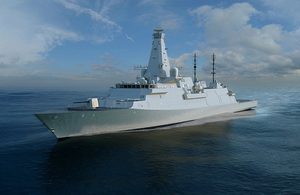2016-12-02 The Royal Navy is in need of new ships and more of them than can be generated by the normal construction process.
A virtually untold story about the building of the new carrier in the UK is how industry –commercial and defense – were mobilized in a very innovative modular construction process to deliver two large deck carriers in a very innovative manner.
In part based on that experience, the UK MoD is looking for new ways to address ship construction in the UK. The report delivered on November 29, 2016 by Sir John Parker is an input to that rethinking process.
In addition for a call to diversity the shipyards involved in delivering the final product, the report calls for a modular construction process to deliver ships to the Royal Navy, which are less complex and more easily configured for exports.

Parker, who is currently chairman of mining company Anglo American, added that the Type 31 frigates should be built quickly to boost navy fleet numbers but also to have a competitive export product that could be designated as Type 31e.
“The new Type 31e should not set out to be a complex and sophisticated warship based on traditional design approaches. It should be a modern and innovative design on a standard platform, which should provide a menu of choice to support exports and beat the competition. It should be termed Type 31e. The ‘e’ means that export flexibility is inbuilt, not a variant,” Parker said.
http://navaltoday.com/2016/11/29/uk-naval-shipbuilding-needs-to-be-quicker-independent-report-finds/
According to a recent story on the UK Ministry of Defence website, the report was described in the following terms:
Sir John Parker’s Independent Report into naval shipbuilding published today (29 November) sets out far-reaching recommendations to transform the United Kingdom’s shipbuilding industry and boost the prosperity of shipyards and supply chains across the country.
Based on extensive consultation with government, industry, and trades unions, it will inform the government’s National Shipbuilding Strategy to be published in the spring.
Sir John’s report is a fundamental reappraisal of how we undertake naval shipbuilding in the UK with the aim of placing it on a sustainable long-term footing.
It enables the foundations to be laid for a modern, efficient, and competitive sector capable of meeting the country’s future defence and security needs.
The report identifies key areas where government and industry must invest in order for UK shipbuilding to thrive:
- Modern digital engineering
- Industrial innovation
- Competitiveness
- Focus on apprenticeships and jobs
- Export-focus
Sir John Parker said:
Should Government, Industry and the Trade Unions rise to the challenges I have set, I believe we can establish a new era of collaboration and success across the ‘Total Enterprise’.
It will create savings over the coming years for MOD, renew the Royal Navy fleet, position the UK for new export opportunities and create regional prosperity and highly skilled jobs across the UK in the Shipyards and supply chain.
One of the opportunities that Sir John identifies is the way Scotland’s cutting edge technology can allow for Modular Construction, in which ship components are produced across the UK before being assembled at a central Hub.
The build of the Royal Navy’s largest ever warships, the Queen Elizabeth Class Aircraft Carriers, has already demonstrated the success of such an approach, with multiple shipyards and hundreds of companies across the UK working together and benefiting from the aircraft carrier build.
Welcoming the report on behalf of the government, Defence Secretary Sir Michael Fallon said:
I would like to thank Sir John for providing an ambitious vision of naval shipbuilding in the UK based on a new era of cooperation as part of our modern industrial strategy.
This report will inform our National Shipbuilding Strategy to match the needs of the Royal Navy with the ability to design and build efficiently, maintain skills, and maximise export opportunities.
This will ensure a strong naval shipbuilding sector and help deliver an economy that works for everyone.
The government will publish a full response, and implementation plan, in spring 2017. This response will be the National Shipbuilding Strategy and a vital part of the government’s industrial strategy that focuses on increasing economic growth across the country and investing in a more skilled workforce.
Sir John’s vision means maintaining Britain’s naval prowess to ensure its role in the world. It also means using the opportunities of Britain’s shipbuilding expertise to become a leading producer of ships for export.
There is already a vibrant shipbuilding and marine engineering sector across the UK. Around 15,000 people are directly employed in UK shipbuilding and repair, with an additional 10,000 jobs indirectly supported through the wider supply chain in the UK. The government is committed to seeing that grow even stronger, with a new focus on exports.
Backed by a rising defence budget, the government is investing billions in a growing Royal Navy building two new aircraft carriers, new Type 26 Global Combat Ships, Dreadnought and Astute class submarines, and offshore patrol vessels. We are also developing a new class of General Purpose Frigate so that by the 2030s we can grow the size of the fleet. This major programme of investment will increase the power and reach of our Royal Navy.
UK MoD
11/29/16
https://www.gov.uk/government/news/parker-review-blueprint-for-a-strong-naval-shipbuilding-sector
uk_national_shipbuilding_strategy_report-final-20161103

